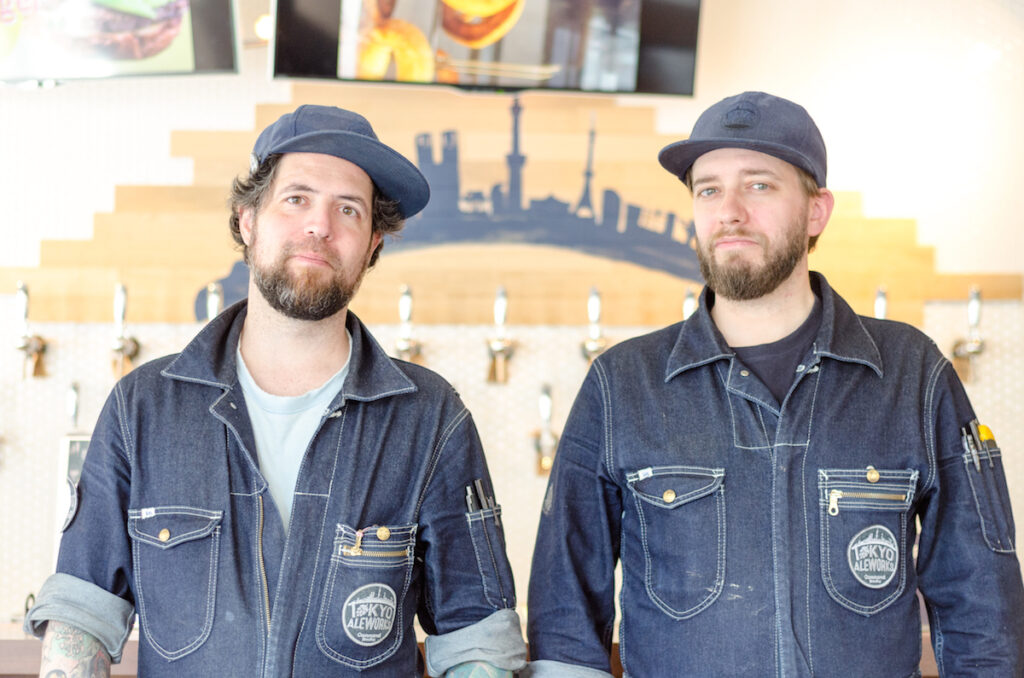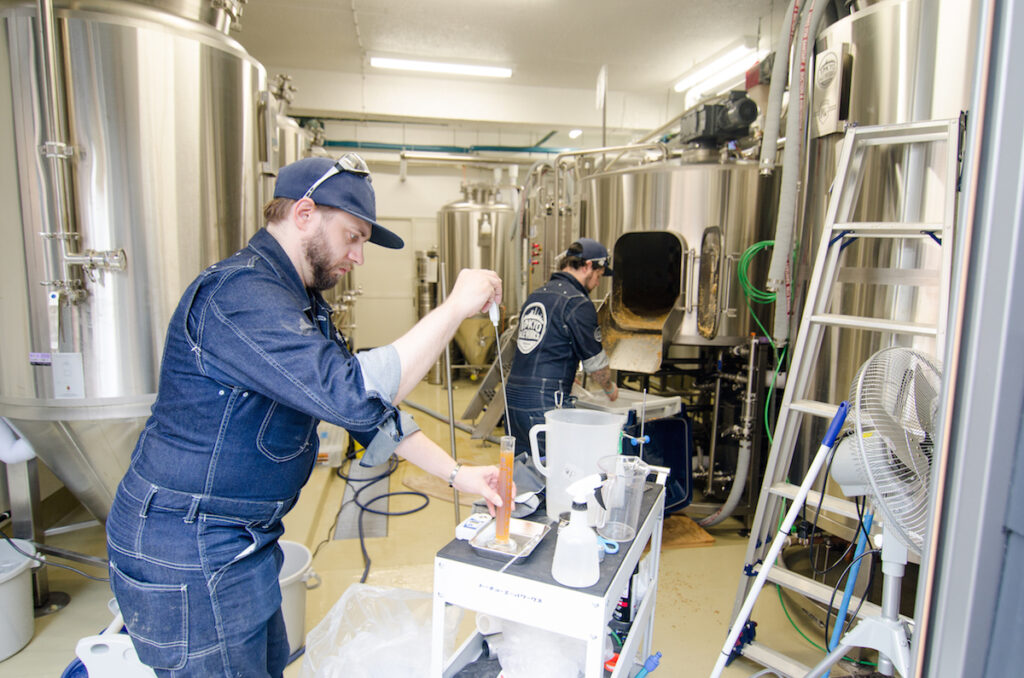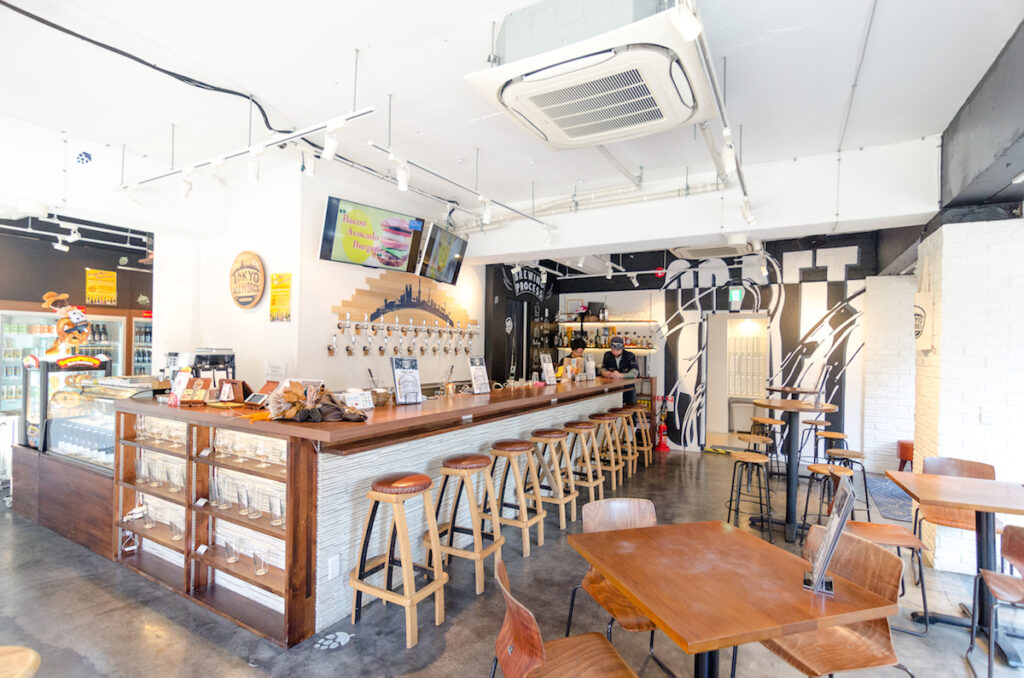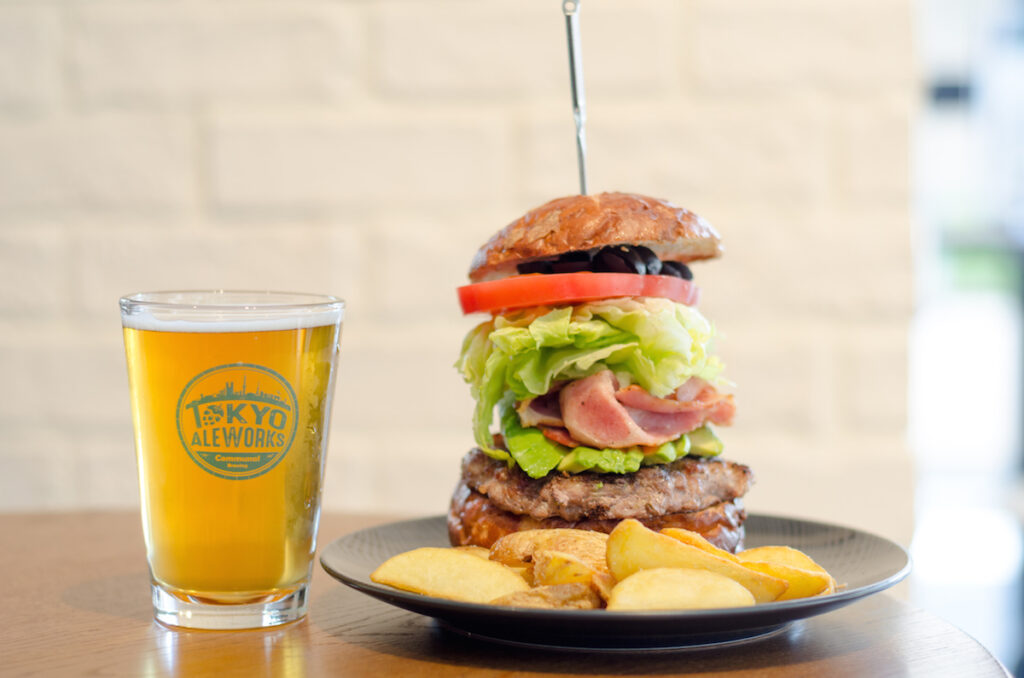Brewing trends in recent years have often revolved around delivering to consumers something new or, in some cases, extreme. Some of the creations that have arisen from the insanity have stuck, like the hazy IPA, while others have sunk in popularity as quickly as they appeared. Bucking these fads, Tokyo Aleworks brewers Bob Stockwell and Randy Carncross are on a mission to take us back to basics. Making exotic brews and chasing trends to satisfy the fickle is not their focus.
Tokyo Aleworks in Itabashi at Tokyo’s northern edge is a brewpub with an added twist. In addition to making its own beers, it offers brewing experiences for novices looking to try their hand at the brewing process. But before getting deeper into that, let’s first take a look at the two men behind the beer. Both have a sense of humor that allows the conversation to go much longer than expected. Comic relief aside, they take their brewing seriously.
I arrive early on a brew day to find Carncross preparing a solution for water treatment and measuring out hops. Stockwell arrives and the pair, decked out in their Tokyo Aleworks coveralls, efficiently move through the brew like a well-oiled machine. The atmosphere is light, but throughout the process there is much monitoring, measurements are taken, and data is properly recorded.
Stockwell, a native of small-town Glens Falls in upstate New York, first came to Japan in 1996 as a high school student. He had developed a passion for kendo and decided that instead of paying exorbitant fees at a dojo in the U.S., he would try life as an exchange student at a Japanese high school, where he could join the kendo club and practice every day for free. Though the language barrier was daunting at first, being young and completely immersed in Japanese helped him pick it up rapidly. A year of school in Asaka, Saitama further fueled his kendo obsession. It also provided a cultural experience that left a strong impression on him. He convinced himself a return for university was needed. A few years later Stockwell enrolled at the University of Tsukuba, “mainly just for kendo stuff, not really to study or anything like that,” he jokes, or more likely, confesses.
One of his kendo club sempai (senior classmates) was a fan of Scotch whisky and invited him out drinking. Well aware that sempai often pick up the tab for kohai (junior classmates), Stockwell was happy to accept every invitation he got. The whisky sessions soon became a regular occurence. Over time he became seriously interested in the beverage and evolved into quite the aficionado. Fast forward to post-graduation: Stockwell stayed in Japan to work as marketing director for a small real estate company in Minami Funabashi, Chiba. In 2008, when the Lehman Shock rocked the world economy, he found himself unemployed.
Around the same time, Stockwell learned that Suntory was looking for a brand ambassador for The Macallan, a popular whisky brand in Japan. He was immediately convinced this was a job tailor-made for him. As he tells it, “I go into the interview completely American-style and tell them, ‘You don’t need to interview anybody else. I’m your man.’ Then I went into a long-winded spiel about how I’m the best candidate for the job and I will let you hire me as long as I get to work at the distillery for at least six months. The three interviewers were looking at each other like ‘Who the fuck is this guy?’” But his self-confidence was convincing and they preferred a technically skilled brand ambassador, so they took him on and flew him to Scotland to work at The Macallan Distillery for six months. Upon returning to Japan, he traveled the country giving whisky seminars for Suntory.
Roughly a year and a half later, in 2010 he was approached by Moët Hennessy Diageo (MHD), who had taken notice of his work. He made them a similar pitch as the one he had given Suntory–he wanted hands-on work at a distillery prior to doing promotional activities. They also acquiesced, sending him to work at Talisker, Ardbeg, and Glenmorangie for one to two months each. He had convincingly talked his way into learning the ins and outs of whisky distilling at some of the most recognized names in the industry.
Over the same stretch of time Stockwell took an interest in craft beer as well, thinking it would be fun to have some experience brewing. He fantasized about having his own distillery, but the initial investment required for such a venture is massive: ¥800~¥1000 million to do it properly in his opinion. Add to that no product sales until at least the third year after production was underway. Starting a craft brewery not only seemed a more realistic goal, but also one in which he could enjoy the fruits of his labor almost immediately, along with an influx of cash. The base science for mashing is the same, but beyond that he needed more intimate knowledge of the entire process. To get an idea of what he might be getting himself into, he befriended the crew at LocoBeer in Chiba, where he lived. Brewmaster Momoyo Kagitani agreed to take him in for about six months off and on. He volunteered his time and in return got a full education in the inner workings of a small brewery. He decided to seriously commit to professionally brewing craft beer and put the whisky distillery idea on the back burner. Stockwell praises Kagitani, saying she “was instrumental in teaching me the ropes of how to work in a microbrewery at that level.”
Near the end of 2017 Itabashi-based company Scotch Malt Sales, an alcohol importer, was looking to start a craft brewery with a component that allowed craft beer fans to brew their own beer on a small-batch system. As they had run into Stockwell at industry events, they knew he was skilled at running entertaining whisky seminars. They envisioned him in the role of educator and director for the planned brewing experiences. But they also had been unsuccessful in finding someone to run the production brewery. As this was exactly what Stockwell had been training for at LocoBeer, it seemed a no-brainer to have him take over that position. But running the entire operation was going to be too much for a single brewer. He needed assistance. Enter Carncross.
Carncross and Stockwell met because both frequented and worked part-time behind the bar at Tokyo’s DevilCraft (Carncross in 2014-15, Stockwell in 2016). The two shared a common fondness for craft beer and also the same home state–Carncross hails from the upstate New York city of Buffalo. They hit it off, discovering they shared similar opinions on craft beer. When Stockwell was tasked with finding a second brewing hand, Carncross was at the top of his list.
Frequent craft-beer-festival goers have surely run into Carncross, who is usually working the taps at some booth. Like many native English speakers residing in Japan, he got his start as a teacher in the JET (Japan Exchange & Teaching) Program. But unlike most, he had actually graduated with a degree in education from Buffalo State College and is a New York state-certified teacher for elementary education and secondary history (the JET program only requires that you have a Bachelor’s or equivalent four-year degree of any sort). But obtaining certification and successfully finding a worthwhile teaching position are two different things. When searching for employment, he found himself in a conundrum. The schools predominantly sought experienced teachers, but he couldn’t get experience if he couldn’t get hired. He then heard about the JET program from friends. In 2003 he decided to take a position in Osaka to add classroom experience to his resume.
Following three years in the JET program, he moved to Tokyo for greater opportunity. He had originally intended to return to New York to teach, but around the five-year mark in Japan, he came to the conclusion that he preferred to stay. About ten years in he was convinced that teaching was a dead-end for him. He wanted to start his own business doing something he was passionate about. He became set on turning an interest in craft beer into his next career, but it was a slow transition. In 2013 he invested in a new craft beer bar, The Hangover, in Nakano, Tokyo. A year later he found himself wanting to move in a different direction. After the stint at DevilCraft, in 2015, he and two partners invested in another new bar–Hopscotch, near Tokyo’s Iidabashi Station. All the while he continued to work at schools or do freelance teaching, which still made up the majority of his income.
In February of 2018, when Stockwell came knocking with the proposal to brew with him, Carncross jumped at the opportunity to finally make it his career. In May of 2018 he came on board as Chief Beer Engineer right as brewing activities were commencing. Recently, he sold his shares of Hopscotch to his partners and his sole focus is now on Tokyo Aleworks. With the brewery’s second anniversary on the near horizon, Stockwell and Carncross have hit their stride.
Stockwell is officially recognized as the Director of Production and QC, but recipe formulation is approached as a team. They bounce recipe ideas off each other and in unison stress the importance of making true-to-style beers they can hang their hats on. Carncross adamantly states, “What I want to say about our beer is everything is Tokyo Aleworks. It’s not my recipes, it’s not Bob’s recipes. It’s our recipes. Regardless of who’s writing the base, it comes down to both of us saying, ‘Yes, let’s do this’ or ‘No, that’s not going to work.’”
Stockwell agrees, “Randy came up with the Back to Basics concept.” The slogan ‘Craft Revolution, Not Just Evolution’ was Stockwell’s addition. He says, “The revolution part is actually about going back and covering the basics.” According to Stockwell, there may come a day when they do some “funky stuff”, but first they want to solidify their reputation as purveyors of quality beers that are textbook examples of the style. He continues, “I don’t want to put out a beer where you’ll have a half pint and you’re trying to get through that last bit saying, ‘This is really interesting (cringing), but… what else do you have on tap?’ We want to make beers that people say, ‘Great, I can have another,’ and continue drinking.”
Currently among those easy-drinking beers, there is no standard lineup, but there are some brews they think are likely candidates, such as the Junior’s Cream Ale (ABV 5.7%, IBU 16), Flagon Filler ESB (ABV 5%, IBU 37), and several beers in the Back to Basics series. The clean, light golden Cream Ale is loosely based on Genesee Cream Ale from Rochester, New York. Stockwell’s father, who sadly passed away before the brewery opened, was a big fan of the beer. His dad was Robert Stockwell II, so they chose the name Junior to honor him.
Rather than having a flagship beer, the Back to Basics series is more like a flagship concept. To date, they’ve made a pale ale, an IPA, a kölsch, and a brown porter. Another two or three are in the works with the intent, as previously stated, to show perfect examples of the classic styles they represent.
This past summer they rolled out another series–kettle sours (see JBT34) made with various fruit purees and dry-hopped like IPAs. The hops used for dry-hopping are selected to complement the fruit. ABV for this series hovers around a very manageable 4%. The one I was able to try during my visit, The Groove is in the Tart Vol. 3 (ABV 4.2%, IBU 6), is made with apricot and Rakau and Amarillo hops. It left me wishing I could have tried Vol. 1 and 2.
To produce small batches, mostly served on premises, a one-barrel system is used. A seven-barrel is utilized for more significant production. Both systems see action about once a week.
As mentioned at the start of this article, there is also equipment for people who want to brew their own beer without getting in trouble with the law (homebrewing over 1%ABV beers is currently illegal in Japan). Tokyo Aleworks has three Blichmann BrewEasy systems for customers to experience most of the process (tax office regulations prevent customers from pitching yeast). There are five basic recipes from which to choose: IPA, pale ale, stout, blonde ale or white ale. Customers do all parts of the process from milling up to transferring their brew to the fermenter. Stockwell or Carncross provide coaching along the way. For around ¥50,000, you get the experience of brewing, two cases (48 bottles) of your own beer, and five tickets to be used for lunch or half pints of beer at the pub. The maximum group size is five and reservations are required. On any given day in the small-scale brewing area, six 20L SS Brewtech Unitank fermenters bubble away with customers’ concoctions approaching completion.
If simply lifting a glass of beer is all the effort you wish to make, the taproom attached to the brewery has 22 taps of primarily in-house brews to choose from. The roomy space is encased in ceiling-to-floor windows making it bright and welcoming. Arnold Schwarzenegger stares down at you from a retro Last Action Hero pinball game in the center of the room. A small, outside deck makes for a perfect spot to relax under the sun in the warmer months. The burgers on the menu tend to be creative, towering pieces of culinary artwork. The pizza pot pie with a beer was too enticing for me to resist.
On the company logo, found all over the taproom, is the phrase “communal brewing” under the Tokyo skyline. As Carncross explains, this refers to a sense that they are a part of the local community. To that end, they participate in the Itabashi Kumin Matsuri and have worked with three different Tokyo charities: Bridge for Smile, Second Harvest, and Sanyukai, which sponsors a free clinic for the homeless in Tokyo’s San’ya area. A sizeable portion of the profits from special beers they sold went to each charity.
If you examine the Tokyo Aleworks logo more closely, hidden in it you will find the words “Itabashi—to–the World”, further indicating community promotion. While making Itabashi a household name among beer fans worldwide is a much grander undertaking in comparison to a good dose of community service, the revolution has to start somewhere. Why not here?
This article was published in Japan Beer Times # () and is among the limited content available online. Order your copy through our online shop or download the digital version from the iTunes store to access the full contents of this issue.







